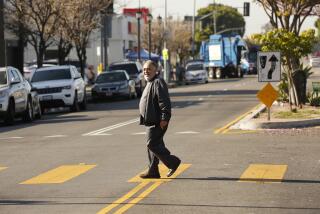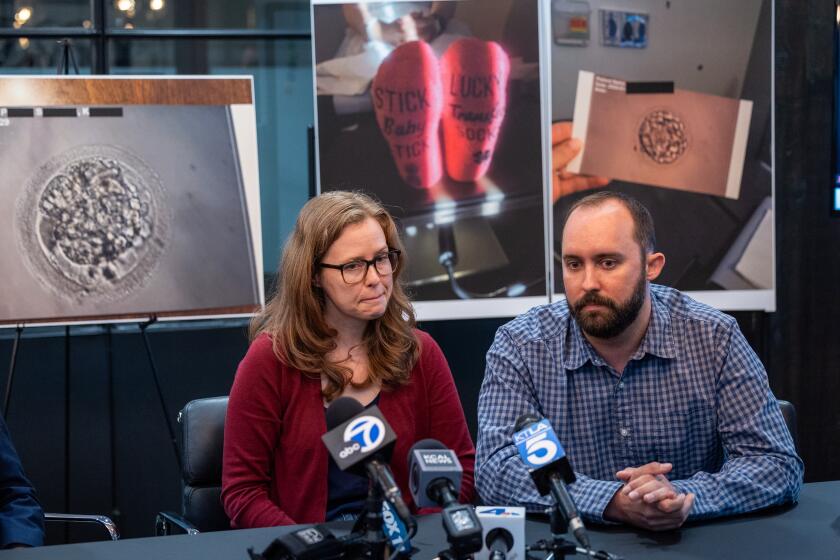First & Spring: Billboard foes fear a betrayal by L.A. Councilman Huizar
When Los Angeles City Councilman Jose Huizar ran for reelection this year, he positioned himself as someone who would stand up to the powerful billboard industry, which has sued the city repeatedly for the right to install more signs.
Facing a challenge from veteran Eastside politician Gloria Molina, Huizar said he opposed amnesty for hundreds of unpermitted billboards. And he talked up his work in drafting an ordinance that would reduce by 90% the number of locations where new billboards could go, limiting them to special “sign districts,” such as Hollywood or parts of downtown.
Huizar easily won his race. But two weeks ago, a council committee that he heads sent proposals to the Planning Commission that, if approved, would run contrary to stances he took as a candidate. That has some billboard foes worried that he is about to abandon the commitments he made during his campaign.
Huizar and his colleagues asked the commission to consider a proposal for granting amnesty for 937 billboards, signs that either have no permit on file or no written permission for an alteration. The councilman’s Planning and Land Use Management Committee also asked the commission to look at letting new digital billboards go up outside sign districts as long as they have what’s known as a conditional use permit.
That proposal would open the door to new electronic signs in nearly every neighborhood in L.A., said Dennis Hathaway, president of the Coalition to Ban Billboard Blight. That’s a far cry from reducing billboard locations by 90%, he added.
“If [Huizar] turns around now and votes for amnesty and votes for allowing digital billboards outside of sign districts, he’s demonstrating that his campaign statements are worthless,” Hathaway said.
Huizar’s chief of staff, Paul Habib, said in an email that his boss stands by his campaign statements. The councilman, he said, will have the opportunity to vote later this year on whatever billboard policy is recommended by the Planning Commission, a panel appointed by Mayor Eric Garcetti. That’s because policy proposals from the commission must be reviewed and approved by Huizar’s committee, and then the full council.
The City Council approved an ordinance in 2002 that banned new billboards in much of the city but allowed them in sign districts, areas zoned for industrial or commercial activities. Council members said at the time that the law would allow the city to take down billboards in many neighborhoods in exchange for letting more go up in high-intensity areas, such as in Koreatown and Century City or around Los Angeles International Airport.
Huizar and his colleagues have been struggling to revise that ordinance since 2009. Facing reporters after his committee’s billboard deliberations, Huizar refused to say whether he supports amnesty for nearly 1,000 billboards. He also declined to say whether digital signs should be approved with a conditional use permit, a document issued by zoning officials, outside of special sign areas.
Huizar said he forwarded those ideas to the Planning Commission because his fellow committee members wanted them to be fully vetted. “When other colleagues and others are interested in hearing an issue ... my job as chair is to move those items along,” Huizar said.
Hathaway voiced dismay at that notion. “This is a case where silence implies support,” he said.
Councilman Gil Cedillo, who serves with Huizar on the planning committee, favors the idea of allowing digital billboards outside of special sign districts. Councilman Mitchell Englander, another committee member, argued last month that electronic signs have a “huge public safety benefit,” because they can display messages from law enforcement agencies.
“I simply want all options explored,” Englander said in a statement.
So far, the billboard industry has welcomed Huizar’s handling of the topic. Stacy Miller, executive director of the L.A. Advertising Coalition, said her group would have been “disappointed” had Huizar’s committee killed the idea of allowing electronic billboards outside special districts. That approach, she said, would provide for community input while ensuring that city officials achieve “significant takedowns of existing static billboards.”
Still, some on the council have begun speaking out. Paul Krekorian, David Ryu, Mike Bonin and Paul Koretz say they oppose allowing digital billboards outside of special sign districts. Koretz promised to oppose electronic signs “in every context,” calling them dangerous and distracting to drivers.
Bonin said billboards should not be approved with a conditional use permit, a document typically provided in Los Angeles for businesses such as bars, restaurants and hotels. And he warned that new exceptions would result in a deluge of new outdoor signs.
“Billboards are a little like cockroaches,” he said. “Once you’ve created an environment that’s conductive to them, they proliferate exponentially and they’re almost impossible to get rid of.”
Joyce Foster, a former member of the city’s Building and Safety Commission, said conditional use permits are the wrong approach for allowing digital billboards. Under the city’s rules, companies that seek such permits are typically required to notify only those who live or own property within 500 feet of the proposed project. That raises the prospect that only people living immediately next to a proposed digital sign would learn about it in advance.
This process “relies on neighborhoods to come and speak and fight each battle individually,” she said. “That’s great when neighborhoods are really together and organized. But a lot of underserved neighborhoods don’t have that.”
Miller, the billboard industry representative, said her group isn’t thrilled with the permitting idea either, but for a different reason: “It’s a very labor intensive process.”
“We understand the community wants input,” she said. “And communities want to decide their own fate. Is it ideal? No. Will we defer to the city and go along with the process they think works best? Yes.”
More to Read
Start your day right
Sign up for Essential California for news, features and recommendations from the L.A. Times and beyond in your inbox six days a week.
You may occasionally receive promotional content from the Los Angeles Times.







